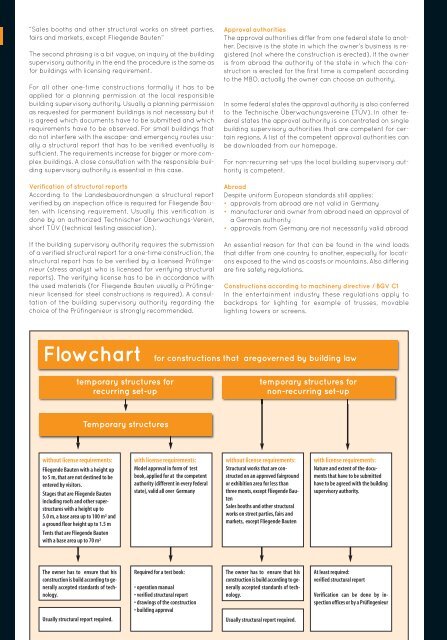o_19jdnovcg1eh21852116govv1lgra.pdf
Erfolgreiche ePaper selbst erstellen
Machen Sie aus Ihren PDF Publikationen ein blätterbares Flipbook mit unserer einzigartigen Google optimierten e-Paper Software.
“Sales booths and other structural works on street parties,<br />
fairs and markets, except Fliegende Bauten”<br />
The second phrasing is a bit vague, on inquiry at the building<br />
supervisory authority in the end the procedure is the same as<br />
for buildings with licensing requirement.<br />
For all other one-time constructions formally it has to be<br />
applied for a planning permission at the local responsible<br />
building supervisory authority. Usually a planning permission<br />
as requested for permanent buildings is not necessary but it<br />
is agreed which documents have to be submitted and which<br />
requirements have to be observed. For small buildings that<br />
do not interfere with the escape- and emergency routes usually<br />
a structural report that has to be verified eventually is<br />
sufficient. The requirements increase for bigger or more complex<br />
buildings. A close consultation with the responsible building<br />
supervisory authority is essential in this case.<br />
Verification of structural reports<br />
According to the Landesbauordnungen a structural report<br />
verified by an inspection office is required for Fliegende Bauten<br />
with licensing requirement. Usually this verification is<br />
done by an authorized Technischer Überwachungs-Verein,<br />
short TÜV (technical testing association).<br />
If the building supervisory authority requires the submission<br />
of a verified structural report for a one-time construction, the<br />
structural report has to be verified by a licensed Prüfingenieur<br />
(stress analyst who is licensed for verifying structural<br />
reports). The verifying license has to be in accordance with<br />
the used materials (for Fliegende Bauten usually a Prüfingenieur<br />
licensed for steel constructions is required). A consultation<br />
of the building supervisory authority regarding the<br />
choice of the Prüfingenieur is strongly recommended.<br />
Approval authorities<br />
The approval authorities differ from one federal state to another.<br />
Decisive is the state in which the owner’s business is registered<br />
(not where the construction is erected). If the owner<br />
is from abroad the authority of the state in which the construction<br />
is erected for the first time is competent according<br />
to the MBO, actually the owner can choose an authority.<br />
In some federal states the approval authority is also conferred<br />
to the Technische Überwachungsvereine (TÜV). In other federal<br />
states the approval authority is concentrated on single<br />
building supervisory authorities that are competent for certain<br />
regions. A list of the competent approval authorities can<br />
be downloaded from our homepage.<br />
For non-recurring set-ups the local building supervisory authority<br />
is competent.<br />
Abroad<br />
Despite uniform European standards still applies:<br />
• approvals from abroad are not valid in Germany<br />
• manufacturer and owner from abroad need an approval of<br />
a German authority<br />
• approvals from Germany are not necessarily valid abroad<br />
An essential reason for that can be found in the wind loads<br />
that differ from one country to another, especially for locations<br />
exposed to the wind as coasts or mountains. Also differing<br />
are fire safety regulations.<br />
Constructions according to machinery directive / BGV C1<br />
In the entertainment industry these regulations apply to<br />
backdrops for lighting for example of trusses, movable<br />
lighting towers or screens.<br />
Flowchart for constructions that aregoverned by building law<br />
temporary structures for<br />
recurring set-up<br />
temporary structures for<br />
non-recurring set-up<br />
Temporary structures<br />
without license requirements:<br />
Fliegende Bauten with a height up<br />
to 5 m, that are not destined to be<br />
entered by visitors.<br />
Stages that are Fliegende Bauten<br />
including roofs and other superstructures<br />
with a height up to<br />
5.0 m, a base area up to 100 m² and<br />
a ground floor height up to 1.5 m<br />
Tents that are Fliegende Bauten<br />
with a base area up to 70 m²<br />
with license requirements:<br />
Model approval in form of test<br />
book, applied for at the competent<br />
authority (different in every federal<br />
state), valid all over Germany<br />
without license requirements:<br />
Structural works that are constructed<br />
on an approved fairground<br />
or exhibition area for less than<br />
three monts, except Fliegende Bauten<br />
Sales booths and other structural<br />
works on street parties, fairs and<br />
markets, except Fliegende Bauten<br />
with license requirements:<br />
Nature and extent of the documents<br />
that have to be submitted<br />
have to be agreed with the building<br />
supervisory authority.<br />
The owner has to ensure that his<br />
construction is build according to generally<br />
accepted standards of technology.<br />
Usually structural report required.<br />
Required for a test book:<br />
• operation manual<br />
• verified structural report<br />
• drawings of the construction<br />
• building approval<br />
The owner has to ensure that his<br />
construction is build according to generally<br />
accepted standards of technology.<br />
Usually structural report required.<br />
At least required:<br />
verified structural report<br />
Verification can be done by inspection<br />
offices or by a Prüfingenieur<br />
204


